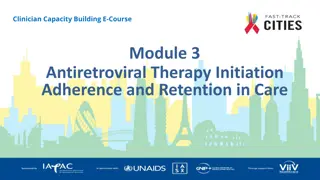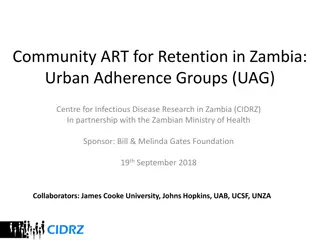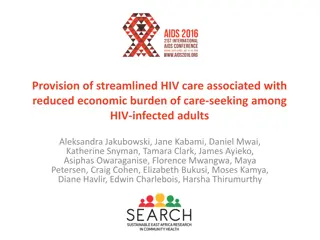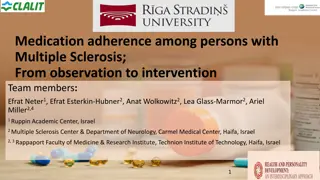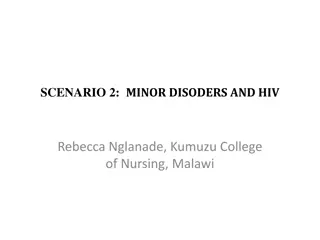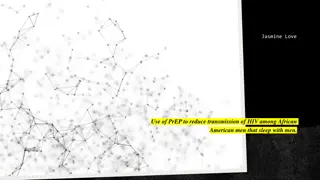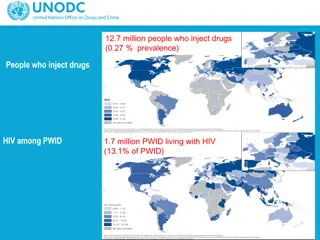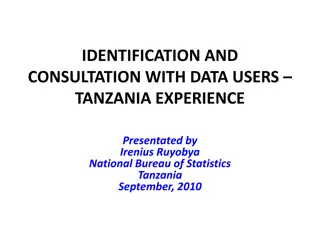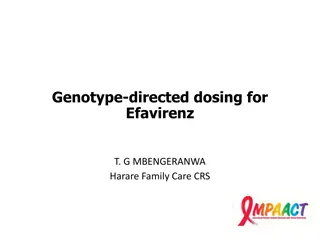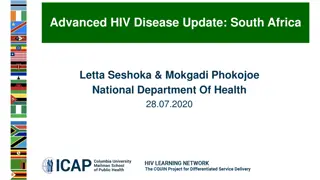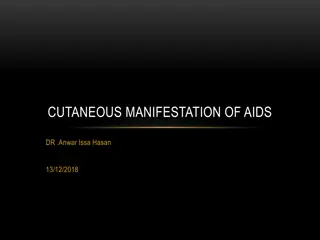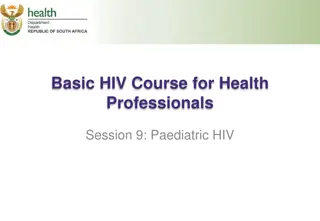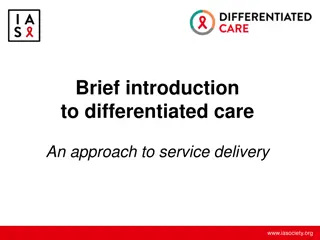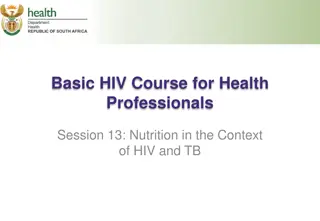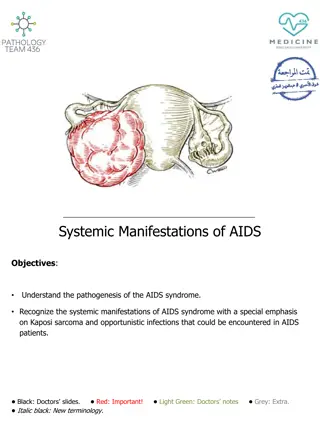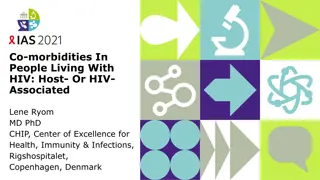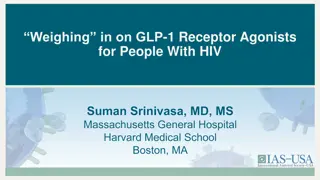Enhancing Adherence and Retention in HIV Care in Tanzania
A pilot study in Tanzania aims to improve adherence to antiretroviral therapy (ART) and retention in care among adults living with HIV. The intervention utilizes social norms and priming techniques to address common challenges like poor adherence, retention issues, and stigma associated with clinic visits. By incorporating behavioral science principles, the study explores the feasibility and effectiveness of interventions based on social norms and priming in enhancing HIV care outcomes.
Download Presentation

Please find below an Image/Link to download the presentation.
The content on the website is provided AS IS for your information and personal use only. It may not be sold, licensed, or shared on other websites without obtaining consent from the author. Download presentation by click this link. If you encounter any issues during the download, it is possible that the publisher has removed the file from their server.
E N D
Presentation Transcript
Pilot Study of a Multi-Pronged Intervention Using Social Norms and Priming to Improve Adherence to ART and Retention in Care Among Adults with HIV in Tanzania Sandra McCoy, Carolyn Fahey, Aarthi Rao, Ntuli Kapologwe, Prosper F. Njau, Sergio Bautista-Arredondo
Poor adherence and retention undermines TasP and other strategies to end the epidemic 35% of people living with HIV (PLHIV) in Africa have dropped out of care within 3 years of starting treatment (Fox, 2015) Traditional behavioral approaches to motivate people to stay in care or adhere to ART often rely on individuals innate desire to remain healthy - Information, education, communication - Often ignore that decisions are influenced by emotions, contexts, and systems as well as decision-making shortcuts outside of conscious awareness (Dolan, 2012)
Behavioral science accounts for predictable irrationalities and biases in human behavior Applies behavioral economics and psychology to behavior change Priming occurs when a stimulus (e.g., images, smells) subconsciously or indirectly influences another behavior (Bargh 1996, Bargh 2014) Social influence occurs when a person's emotions, opinions, or behaviors are affected by others - For example, HIV prevention programs based on opinion leaders attempt to influence social norms (NIMH Collaborative HIV/STD Prevention Trial Group, 2010)
Common Clinic Experience Long wait times Anxiety about negative provider interactions and stigma Concern about disclosure Clinic valued as a source of social support
Study Goals Objective: Evaluate the feasibility, acceptability, and short-term effectiveness of an intervention based on social norms and priming to improve adherence and retention in care among PLHIV in Tanzania. Trial Registration: Clinicaltrials.gov, NCT02938533 Ethical Approvals: National Institute for Medical Research and UC Berkeley Protocol / Results: McCoy SI et al. PLoS ONE 12(5): e0177394.
Study Setting & Population Two HIV primary care clinics in Shinyanga, Tanzania Inclusion criteria: 1. 18 years 2. living with HIV infection 3. On ART at study initiation
Patient-Centered Design Empathize Define Ideate Prototype Test A creative, empathetic approach that draws on ethnographic methods and relies on rapid prototyping and user testing (IDEO.org, 2015) Household and clinic observations, photo-based interviews, and in-depth semi-structured interviews with patients and providers Identified patient segments and created journey maps Tools used to guide business and marketing innovation, which describe a group s perception of health, barriers to ART adherence, and potential interventions Sources: The Hasso Plattner Institute of Design, Stanford University McCoy SI et al. PLoS ONE 12(5): e0177394.
We created personas for 5 patient segments to illustrate nuanced challenges facing patients. The No Tomorrows segment describe young people who are asymptomatic and primarily motivated by social aspirations such as marriage. Ideal interventions for this segment are discreet, support immediate social goals, and impart a long- term perspective. To view all 5 patient segments visit: http://mccoy.sph.berkeley.edu/patient -personas/
We also created patient journeys to map the treatment experience. Patient journey maps chart the experiences of each of segment of people living with HIV from diagnosis to long- term adherence behavior.
Multi-component intervention leverages social norms and a self-relevant prime Relevant Insights from Formative Work Intervention Description Locally recognizable image of a Baobab tree and local idiom: Together we can hug the Baobab tree Appears on every component Patients lack reminders of support available at the clinic through peers and providers The ubiquitous Baobab tree is strongly associated with health, resilience, and community Prime
Multi-component intervention leverages social norms and a self-relevant prime Relevant Insights from Formative Work Intervention Description Locally recognizable image of a Baobab tree and local idiom: Together we can hug the Baobab tree Appears on every component Patients lack reminders of support available at the clinic through peers and providers The ubiquitous Baobab tree is strongly associated with health, resilience, and community Prime Useful take home item that features the prime and reminds patients of the clinic One group received a calendar with images featuring health/vitality and others received a pill box with the approximate dimensions of a feature phone Disclosure and stigma are significant challenges patients go to great lengths to hide treatment Patients lack frequent touch points with the clinic Patients ignore clinic materials and instead associate health with images from daily life Take-home Component
Multi-component intervention leverages social norms and a self-relevant prime Relevant Insights from Formative Work Intervention Description Locally recognizable image of a Baobab tree and local idiom: Together we can hug the Baobab tree Appears on every component Patients lack reminders of support available at the clinic through peers and providers The ubiquitous Baobab tree is strongly associated with health, resilience, and community Prime Useful take home item that features the prime and reminds patients of the clinic One group received a calendar with images featuring health/vitality and others received a pill box with the approximate dimensions of a feature phone Disclosure and stigma are significant challenges patients go to great lengths to hide treatment Patients lack frequent touch points with the clinic Patients ignore clinic materials and instead associate health with images from daily life Take-home Component Interactive poster for positive provider- patient interactions patients place sticker after 3 consecutive appointments As image grows, patients visualize that others succeed in attending appointments Patients seek trustworthy and well run clinics, but provider interactions are unpredictable Patients value clinic as a source of social support Some patients assume others are non-adherent Clinic-based Component
Evaluation Design Feasibility and acceptability: Patient satisfaction with an anonymous survey of clinic ART patients at baseline and endline (6 months) Short-term effectiveness: Quasi-experimental, 6-month pilot study Intervention implemented every two weeks for 6 months starting 8/2015 Given 30- & 60-day schedules, most exposed only to intervention or standard of care Association between intervention exposure and outcomes expressed as ORs and mean differences (weighted to account for sampling strategy)
Outcomes Primary Outcomes: Retention in care at 6 months - 1 visit 150 210 days after baseline (6 months +/- 30 days) ART adherence at 6 months - Measured with the medication possession ratio (MPR), the proportion of days that an individual is in possession of 1 ART dose - MPR 95% Secondary Outcome: Appointment adherence during the 6-month study period - Proportion of scheduled visits that were completed
Results: Feasibility and Acceptability Baseline (n=189) N (%) Endline (n=216) N (%) Perceptions of adult clinic attendees Staff support treatment goals 180 (95.3) 216 (100)* Staff support life goals 94 (49.8) 143 (66.2)* Enjoy being at the clinic 154 (81.5) 186 (86.5) Other patients support me 114 (60.3) 153 (70.8)* Unanswered questions today 72 (38.1) 53 (24.5)* Likelihood of others being adherent 60 (31.7) 116 (53.7)* Very satisfied with services and care 65 (34.6) 115 (53.2)* * p<0.05 from chi-squared test
Results: Patient Characteristics Intervention N=320 (%) Comparison N=118 (%) p-valuec Characteristica Age 18-29 30-39 40-49 50 18% 32% 28% 22% 16% 35% 26% 23% 0.80 62% 54% 0.07 Female Time on ART at Baseline 90 days or less 3-12 months 1-3 years More than 3 years 13% 19% 28% 40% 10% 14% 39% 37% 0.07 74% 73% 0.78 Baseline Appointment Attendanceb a. Weighted statistics to account for sampling strategy. b. Attendance at the last two scheduled appointments prior to the intervention period. c. Chi-squared test.
Results: Retention and ART Adherence 1.00 87% 79% Intervention Comparison Proportion of Patients 73% 70% 0.80 66% 59% 0.60 0.40 0.20 0.00 In care at 6 months* Visit attendance MPR 95% ORa (95% CI): 1.73 (1.08, 2.78)* 1.51 (0.96, 2.37) Mean diff: 0.04 (-0.01, 0.09) * p<0.05. Quasi-experimental study with 438 patients (320 intervention, 118 standard of care) in Tanzania, 2015-2016.
Limitations Study conducted at two facilities in Tanzania - Future studies needed to understand the generalizability of the approach Intervention evaluated as a combination package - The effect of individual components not measured Imperfect measurement of intervention exposure IV sensitivity analysis supports primary analysis that the intervention may have improved retention in care and potentially ART adherence Viral load not measured - MPR correlated with viral suppression (McMahon et al., 2011; Hong et al., 2013)
Discussion (1) Novel approach: design thinking + behavioral science + evaluation - (McCoy & Rao. Optimizing on the Edges. Stanford Social Innovation Review; 6/2017) - Goal to address behavioral gaps by improving the patient experience Low-cost intervention was feasible and acceptable to patients and staff - Intervention associated with temporal improvements in perceived support from staff and other patients and satisfaction with clinic services.
Discussion (2) The intervention was positively associated with retention in care and potentially with MPR 95% over a short 6-month follow-up period. Although the intervention is specific to this study population, the design and evaluation approach may lead to locally relevant solutions in different geographic areas and for various health outcomes.
Acknowledgements UC Berkeley Ms. Aarthi Rao Ms. Carolyn Fahey Ms. Nancy Czaicki Ministry of Health, Gender, Community Development, Elderly and Children Dr. Prosper Njau Shinyanga Regional Medical Office Dr. Ntuli Kapologwe Ms. Agatha Mynippembe Mr. Kassim Hassan Financial Support Bill & Melinda Gates Foundation (Grand Challenge Explorations)
Study Flowchart First 4 study weeks (August 10 September 4, 2015) 2 weeks allocated to intervention 2 weeks allocated to standard of care 393 patients sampled retrospectively from clinic registers in Jan-Feb 2016 149 patients sampled retrospectively from clinic registers in Jan-Feb 2016 73 patients excluded: 53 had no other medical records 20 did not meet inclusion criteria 14 children 6 not yet on ART 31 patients excluded: 20 had no other medical records 10 did not meet inclusion criteria 10 children 1 transferred same day sampled 320 patients analyzed 118 patients analyzed
These results appear to stem from our intervention s ability to strengthen clinic- based relationships, change expectations, and motivate patients to achieve their goals. Prescriber Interaction Waiting room experience Returns home Falls off treatment Typical experience Typical experience Typical experience Typical experience Health provider scolds patient for missing appointments Patient assumes everyone skips appointment Patient returns to work, forgets about clinic Patient starts to take medication intermittently, experiences treatment interruptions or falls out of care Patient does not disclose fears or treatment goals Patient ignores adherence materials Patient feels isolated, has no connection to clinic Intervention experience Intervention experience Intervention experience Intervention experience Patient views health staff favorably when viewing poster interactions Patient creates subconscious connection between prime image and positive recognition Patient sees prime on useful object (pill box / calendar) and is reminded of other patients and staff Prime subconsciously influences patient to stay on treatment to achieve personal goals and receive positive recognition from staff Provider views patients more positively when noticing eligibility for sticker; relationships build Patient sees many others succeed w/ visit adherence Patient sees Baobab trees and is reminded of prime s message


